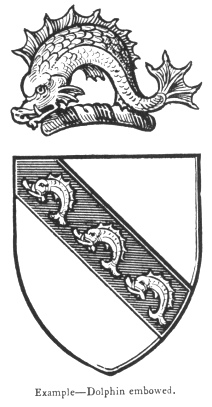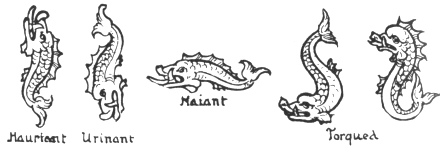
Masonic, Occult and Esoteric Online Library
Fictitious and Symbolic Creatures in Art
By John Vinycomb
Fictitious Creatures of the Sea- The Heraldic Dolphin
The heraldic dolphin, as, usually represented by modern heralds, is an ornamental monstrosity bearing but slight resemblance to

the natural form of this celebrated historic marine symbol; a nearer resemblance to the natural shape is decidedly preferable. Some of the early heraldic representations, though a little crude, are very characteristic and thoroughly heraldic in treatment, though at the same time very unlike the real dolphin.
In its series of leaps out of the water the dolphin appears with high arched back, just as we see it represented in antique works; its natural shape, however, is straight, the back being but slightly curved. The broad tail paddle being placed in a horizontal position necessitates an up and down stroke, which makes their swimming to appear a series of leaps and divings. Like its near relative the porpoise, it is an air-breathing animal; its apparent gambollings on the water may, therefore, be more truly attributed to its breathing and blowing whilst in pursuit of its prey.
The Dolphin is generally, if not always, depicted in heraldry embowed, that is, having its back greatly incurvated. In blazon the word Dolphin, alone, implies that its natural position, naiant (swimming) and embowed, is understood, but for the sake of accuracy it is better always to give the description in full, as a doubt may arise as to the omission of a word indicating its position.
Torqued, torquend, torgant, or targant, from the Latin torquere, to twist, are old terms for embowed, or bowed embowed, bent in the form of the letter S, turning contrary ways at each bending; applicable also to serpents.
Hauriant, from the Latin ab hauriendo, is a term applied to fishes generally when placed in an upright position or in pale, as if putting the head above water to get air.

Shell-fish are blazoned erect or upright, the term hauriant being only applicable to fishes with scales and fins.
Urinant (from the Latin urino, to duck or dive under water) signifies borne with the head downwards and the tail erect, the reverse position of hauriant.
Two dolphins are occasionally borne together, sometimes endorsed, or back to back; sometimes respecting each other.
As signifying the conquest of the sea, it appears in the shields of many seaport cities. It figures on the well-known bearings of the towns of Brighton, Dunkirk, Poole, &c.
The Dolphin appears in English heraldry as early as the middle of the thirteenth century. In a roll of arms of that date, a dolphin is given as the coat of Gile de Fiseburn.
"The Godolphins of Helston," says Miss Millington, "who had estates in that part of the kingdom (Cornwall) at the time of the Conquest, bore argent three dolphins embowed, sable." Similar arms are borne by many English families.
The Godolphins, Franklins, Franklands, Frenches, Fishers and Kennedys, in many of their branches, bear the dolphin fish as their crest.
A man playing the harp on a dolphin is the heraldic cognisance of the Walterton family.
